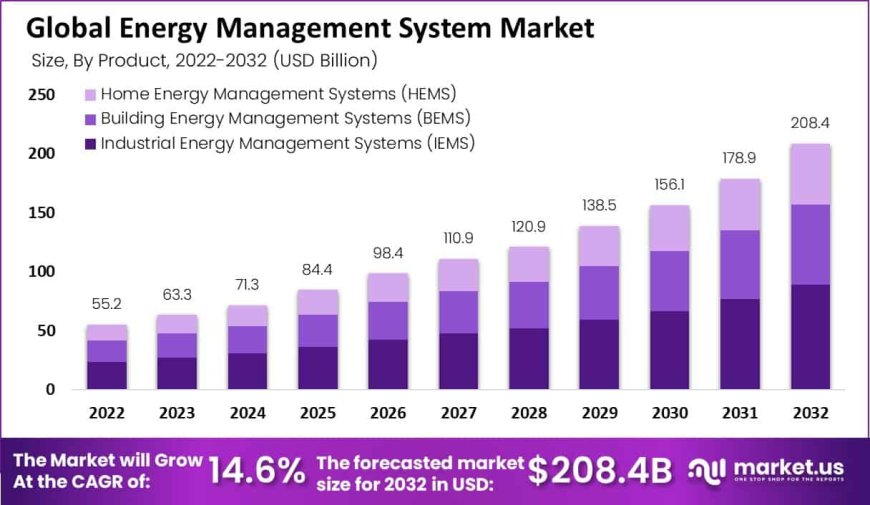Energy Management System Market 2023 Key Segments and Sub-Segments, Key Drivers, Restraints, Opportunities and Challenges by 2032
In 2022, the Global Energy Management System Market was estimated at USD 55.2 Billion and projected to reach approximately USD 208.4 Billion by 2032 - experiencing compound annual compounded annual growth at 14.6% during that time frame.

Market Overview
The Energy Management System Market Dynamics Market is expected to experience substantial growth over the coming years, driven by rising energy costs, an increasing desire for energy efficiency, government support for energy conservation efforts and technological developments within EMS solutions as well as greater adoption of smart grids and meters.
In 2022, the Global Energy Management System Market was estimated at USD 55.2 Billion and projected to reach approximately USD 208.4 Billion by 2032 - experiencing compound annual compounded annual growth at 14.6% during that time frame.
Market Trends of Energy Management Systems:
Drivers:
- Government policies and regulations: Governments around the world have increasingly instituted policies and regulations designed to increase energy efficiency and lower greenhouse gas emissions, which has increased demand for EMS solutions that help organizations meet these requirements.
- Rising energy costs: Energy costs continue to escalate, making it increasingly critical for organizations to manage their energy consumption efficiently and reduce consumption costs effectively. EMS solutions can assist organizations in implementing cost-cutting measures which may lead to significant cost savings over time.
- Increased Awareness of Environmental Sustainability: Organizations have become more aware of their need to operate sustainably. EMS solutions can assist these companies by helping reduce energy usage and greenhouse gas emissions, thus lessening their environmental footprint.
- Technological Advancements: Technological advancements have made EMS solutions more cost-effective and easier to implement, increasing their accessibility for more organizations.
Free PDF Sample of Our In-depth Report: https://market.us/report/energy-management-system-market/request-sample/
Restraints:
- High initial investment costs: EMS can be expensive to install and implement, especially for large and complex systems. This can be a barrier to adoption for small and medium-sized enterprises (SMEs).
- Lack of awareness and expertise: Many businesses are not aware of the benefits of EMS or how to implement them effectively. This can be a barrier to adoption, even for businesses that have the financial resources to invest in an EMS.
- Data security and privacy concerns: EMS collect and store large amounts of data about energy consumption. Businesses may be concerned about the security and privacy of this data, which could deter them from adopting an EMS.
- Resistance to change: Implementing an EMS can require significant changes to business processes and culture. This can be a challenge, especially in large and complex organizations.
Opportunities:
- Government Policies and Regulations: Governments worldwide have initiated policies and regulations designed to decrease energy consumption and greenhouse gas emissions, creating demand for EMS solutions which enable organizations to meet their energy efficiency targets more easily.
- Rising Energy Costs: With energy prices continually rising worldwide, organizations must work to manage their energy consumption effectively in order to minimize energy waste and keep costs at a manageable level. EMS solutions can assist organizations by helping identify and eliminate unnecessary energy consumption waste that contributes to higher costs overall.
- Renewable Energy Growth: With renewable energy sources like solar and wind power growing increasingly popular, new opportunities have arisen for energy management systems (EMS). Organizations can leverage EMS solutions to integrate renewable sources into their energy mix while optimizing energy use.
- Digital Transformation: Digital transformation involves adopting innovative technologies like cloud computing, big data analysis, and analytics in order to improve EMS solutions' effectiveness.
Challenges:
- Cybersecurity Issues: With so much connectivity between EMS systems and the internet, they become vulnerable to cyber attacks. Organizations should take proactive measures in order to safeguard their EMS against potential risks.
- Integration Challenges: Environmental management systems can be complex systems to integrate into existing IT infrastructure, creating difficulties for organizations with limited resources or expertise.
- Lack of Awareness: Unfortunately, many organizations are still unaware of the many benefits offered by an Energy Management System and how it can improve energy efficiency - this lack of awareness can severely impede market expansion.
- High Initial Costs: When it comes to deploying an EMS, initial costs may be prohibitively expensive for large and complex organizations - this can act as a barrier for some small and medium-sized enterprises (SMEs).
Market Key Segments
Product
- Building Energy Management Systems (BEMS)
- Home Energy Management Systems (HEMS)
- Industrial Energy Management Systems (IEMS)
Component
- Hardware
- Software
- Services
Solution
- Demand Response Management
- Utility Billing & Customer Information System
- Carbon Energy Management
Deployment Mode
- On-Premises
- Cloud-Based
End-Use Industry
- Manufacturing
- Retail & Offices
- Healthcare
- Power and Energy
- IT & Telecommunication
- Residential
- Other End-Use Industries
Market Key Players
- Emerson Process Management
- Elster Group GmbH
- Daintree Networks
- Siemens AG
- Honeywell International Inc.
- General Electric Company
- Cisco Systems
- Schneider Electric
- C3 Energy
- Daikin Industries
- Johnson Controls
- Other Key Players
Contact us
Global Business Development Team: Market.us
Market.us (Powered By Prudor Pvt. Ltd.)
Send Email: inquiry@market.us
Address: 420 Lexington Avenue, Suite 300 New York City, NY 10170, United States
Tel: +1 718 618 4351, +91 78878 22626












